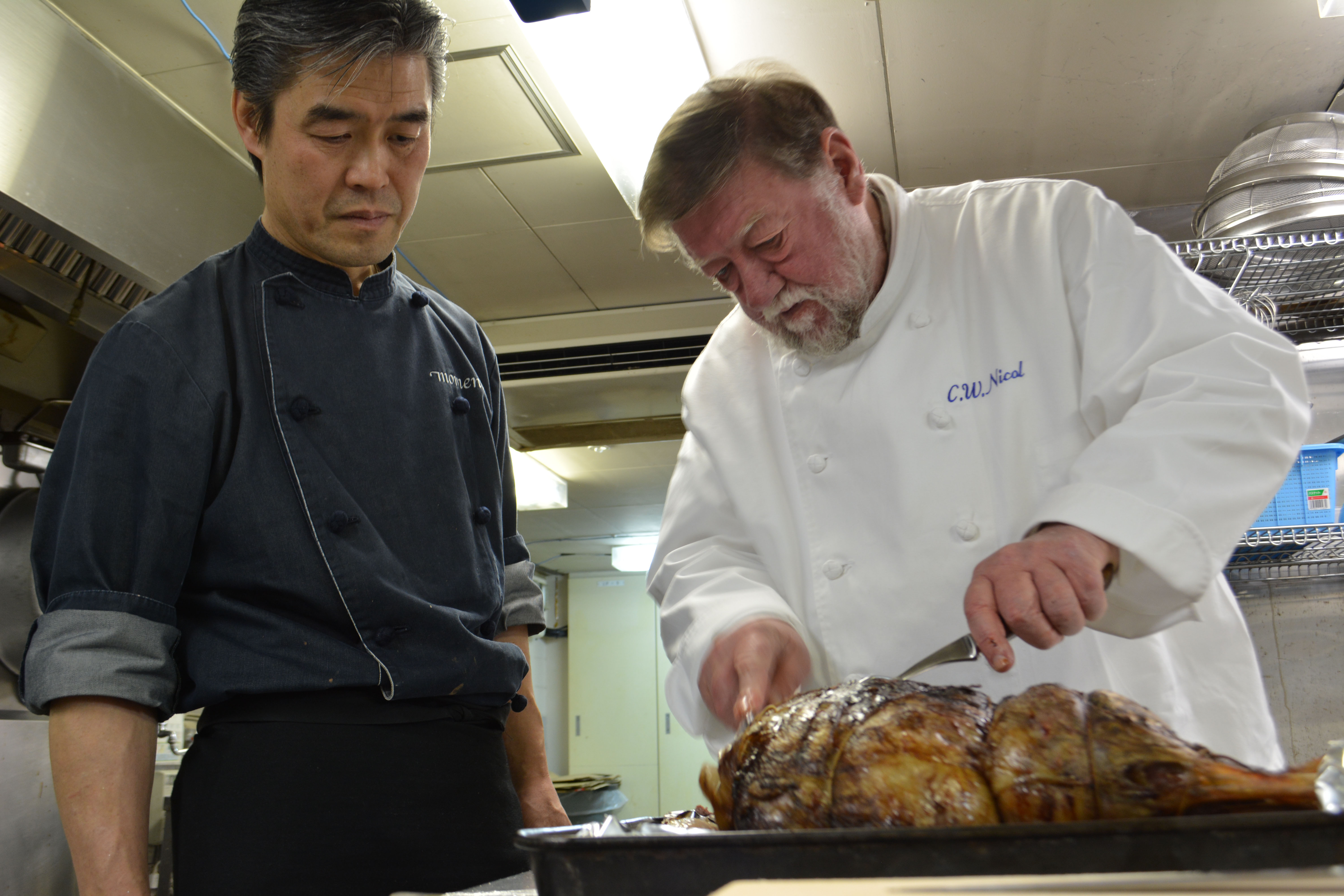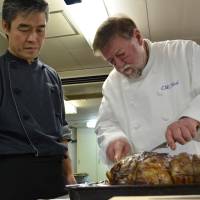In summer this year, my photographer chum Conan Morimoto brought a fashion-designer friend of his by the name of Teruki Uchise to talk to me and visit our Afan Trust woods outside Kurohime in the Nagano Prefecture foothills of the Northern Alps.
Most unusually for a Japanese person who's not a yakuza gangster, Teruki — who sported a T-shirt of his own design, brand-label jeans and a funny little hat — is spectacularly tattooed and has pierced ears from which dangle decorations that look like the tusks of wild boar, though they're actually carved from fossil mammoth tusks.
Conan had prepared me for the meeting, saying, "Teruki is a bit different, but he's a really great guy" — which was good enough for me.
It was a fine day, so I bought some tomatoes and cucumbers and chicken to cook over a campfire, and beers to cool in a spring. I simply put the chicken in a frying pan with a tight-fitting lid, having already added salt, black pepper and lots of freshly picked leaves of wild garlic.
While we were having our picnic, Teruki asked me if there was any particular material taken from Japan's nature that did not endanger anything or have any detrimental effects — and which could actually contribute to forest conservation.
I told him there surely was, in particular deer hides and antlers — and I showed him my wallet and my name-card holder, which are both made of tanned and decorated deer hide that's known as inden in Japan. Later, I also showed him a buckskin shirt my son sent me from Canada 30 years ago, but which is still in good shape though well used.
I told him that although deer hide was traditionally used in Japan for making many things, including armor and kendo gear, nowadays tens of thousands of deer carcasses with their hides intact are being thrown away, burned or buried every year.
I have written about this here before, but now, again — with the hunting season in full swing — I want to bring the subject back to everybody's attention.
Deer appear to be on the increase. Though we never used to, we now regularly get them in our Afan Woodland Trust as the number of hunters in Japan continues its steep decline. In our little local town of Shinanomachi, for instance, there were 76 registered hunters 30 years ago — now there are just over 20.
Deer are causing billions of yen of damage to pastures, vegetable fields, paddies, orchards and forests. In the woods, they strip the bark off trees and eat young saplings.
As a result of all this, the government encourages hunters to kill deer by paying them an amount for every tail they bring in. It's hard to get up-to-date data, but the numbers I have for 2011 suggest that 123,251 deer were killed that year by people issued with Pest Extermination Permits, while another 183,619 were killed in the season by people with regular hunting permits.
But the awful thing is that 95 percent of all those deer were buried, burned or just dumped, with the totals increasing every year over the last 10 years.
Among other reasons, such waste is awful because, from a single adult Japanese sika deer, I can prepare and serve at least 100 meals — while a larger Ezo deer from Hokkaido will yield 120. At home here in Nagano, I use four to six whole deer each year for family and guests.
Personally, I think that throwing away enough good protein to provide a hearty meal for well over 30 million people (Yes — just do the math!) is a crime — and that in a country where people pride themselves on avoiding accusations of mottainai (meaning, "what a waste"), it is plainly hypocritical. Moreover, although no other nation tolerates such a colossal waste across the length and breadth of its territory, how can Japan also insist that because it doesn't have sufficient protein resources it must preserve "tradition" by sending ships to the Antarctic to kill minke whales?
If the money spent on Antarctic whaling was instead channeled into the humane culling of wild deer and the processing of their meat and other useful parts, it would go a long way to resolving the problem as well as giving much-needed employment to country folk.
Things are actually getting a little bit better at home, with new regulations on the handling of wild game meat such as deer and wild boar that have seen a few facilities opened to handle it — but the process is very slow. And really, isn't it a sick, sad joke that many expensive restaurants and hotels in Japan boast menus featuring imported New Zealand venison?
Many Japanese people will insist there's no custom of eating deer meat here, but the evidence from ancient times — and my own experience of living and traveling in the mountains — says otherwise.
In addition, in terms of healthy eating, venison is especially low in fats and high in amino acids, minerals and vitamins — and it is far, far better than the fatty and hugely expensive beef that Japanese chefs are so proud of.
Here in Nagano, for the last six years when the autumn colors are at their best, myself and Makoto Ozawa, head chef at the El Bosco Hotel on Lake Nojiri, have prepared a dinner there for between 50 and 60 special guests. We use local organic vegetables and freshwater fish, all kinds of mushrooms, chestnuts and so on — but the main meat course is (of course) always venison.
This year, in fact, a single haunch of Hokkaido venison — which we garnished with a sauce made of local blueberries — provided generous portions for everyone, with plenty left over for the staff.
People book months in advance to be sure of having a seat at our table and a bed in the hotel, and this year only one person didn't eat the venison — but she was a vegetarian. Otherwise, nobody left any on their plate.
In other years at El Bosco, I have prepared shepherd's pie and a meat sauce for spaghetti, both using minced venison — while at our splendid new Afan Woodland Trust Centre I regularly serve venison and wild boar to all manner of guests, whether young or old, Japanese and otherwise. So far, there's not been a single complaint — with venison keema curry and venison burgers especially popular of late, I've noticed. This year, after dinner at El Bosco was over and I'd hung up my chef's jacket and changed to go into the bar for a few drinks and to talk with guests, I wore a unique, specially tailored jacket that was designed and made especially for me by Teruki.
Light, warm, comfortable, soft to the touch and lined with silk, the snazzy garment can be sported either casually or formally — and it's made of Ezo deer hide taken in Hokkaido, tanned in Wakayama Prefecture and softened and bleached by Teruki himself.
So far, I've worn it for several lectures I've given and to a couple of parties. The ladies especially are wowed by it, and almost all of them want to stroke the jacket — even with an old and wrinkled red devil inside. If it was worn by a good-looking young man he would be mobbed.
Nowadays, it's hard to get Japanese hunters to skin a deer — which puzzles me, because that's an essential step before the animal can be properly butchered. However, as fashion-designer Teruki wants to include Japanese deer hide in a new El Bandido line he's creating to sit alongside his successful 14th Addiction one, I am now trying to help him source a regular and reasonably priced supply of hides. Of course it would be far cheaper and easier to import them, but he wants to work with Japanese natural material and by so doing assist in forest and woodland conservation.
I am very pleased to have met my new friend Teruki — and I'm supremely proud of my new jacket, which I'm sure will last at least as long as my trusty old buckskin shirt.




















With your current subscription plan you can comment on stories. However, before writing your first comment, please create a display name in the Profile section of your subscriber account page.